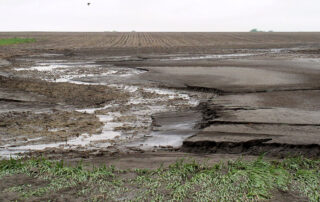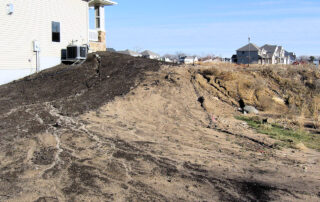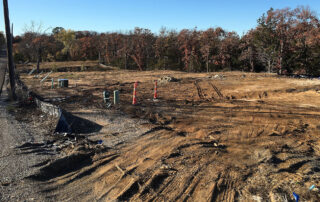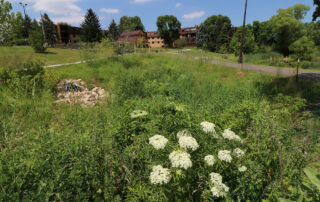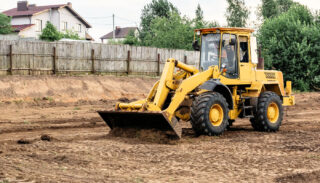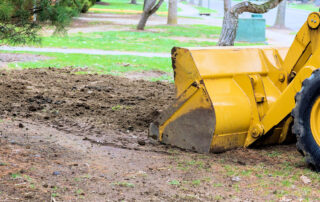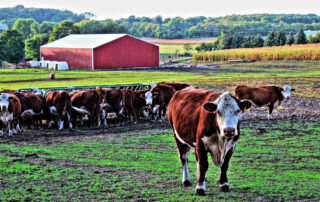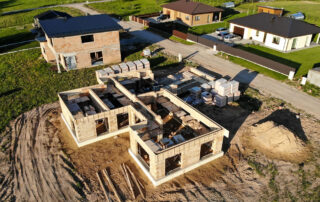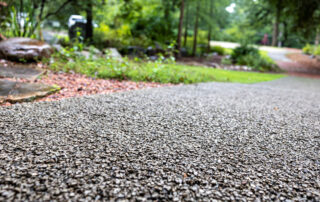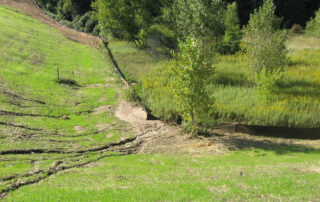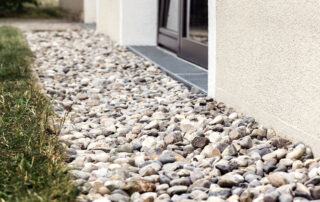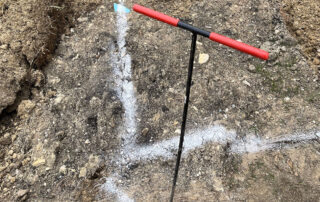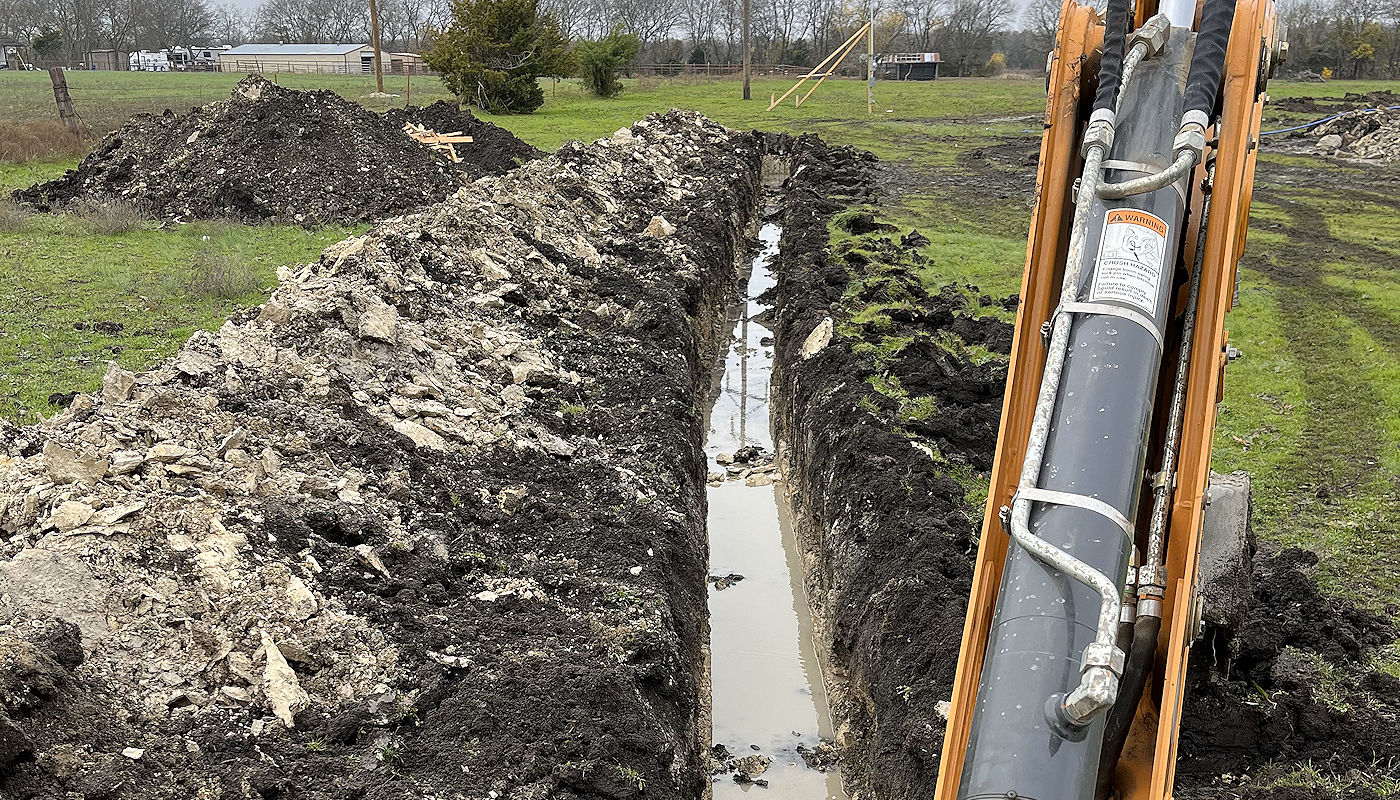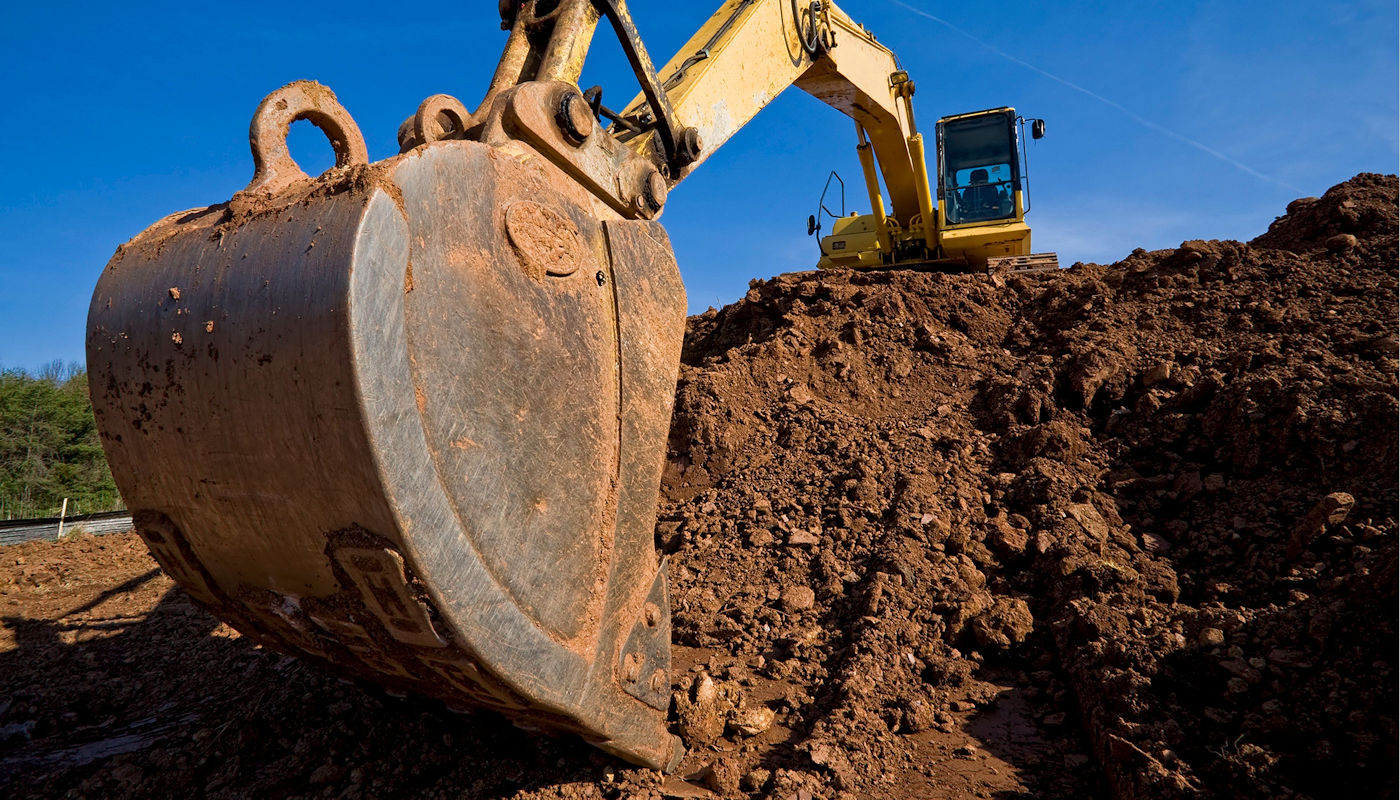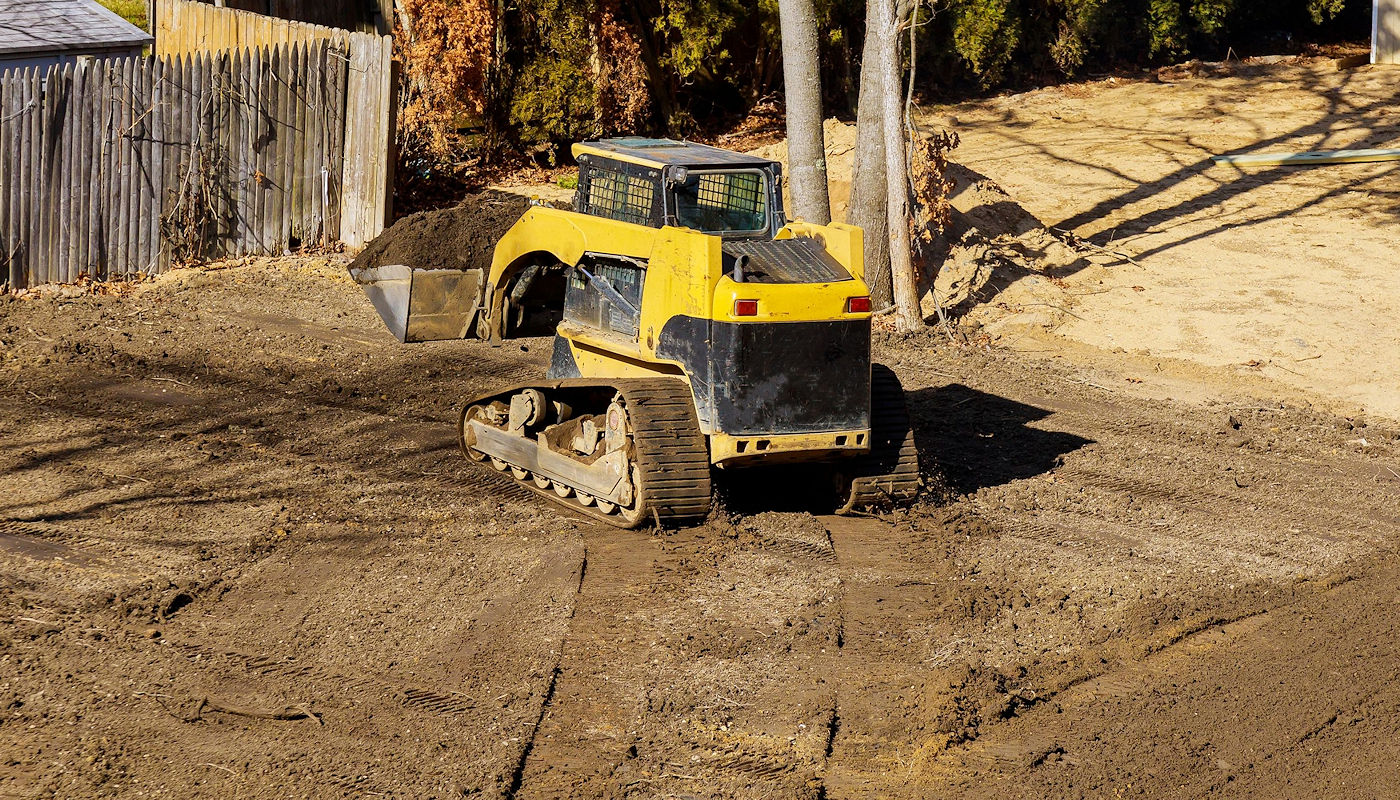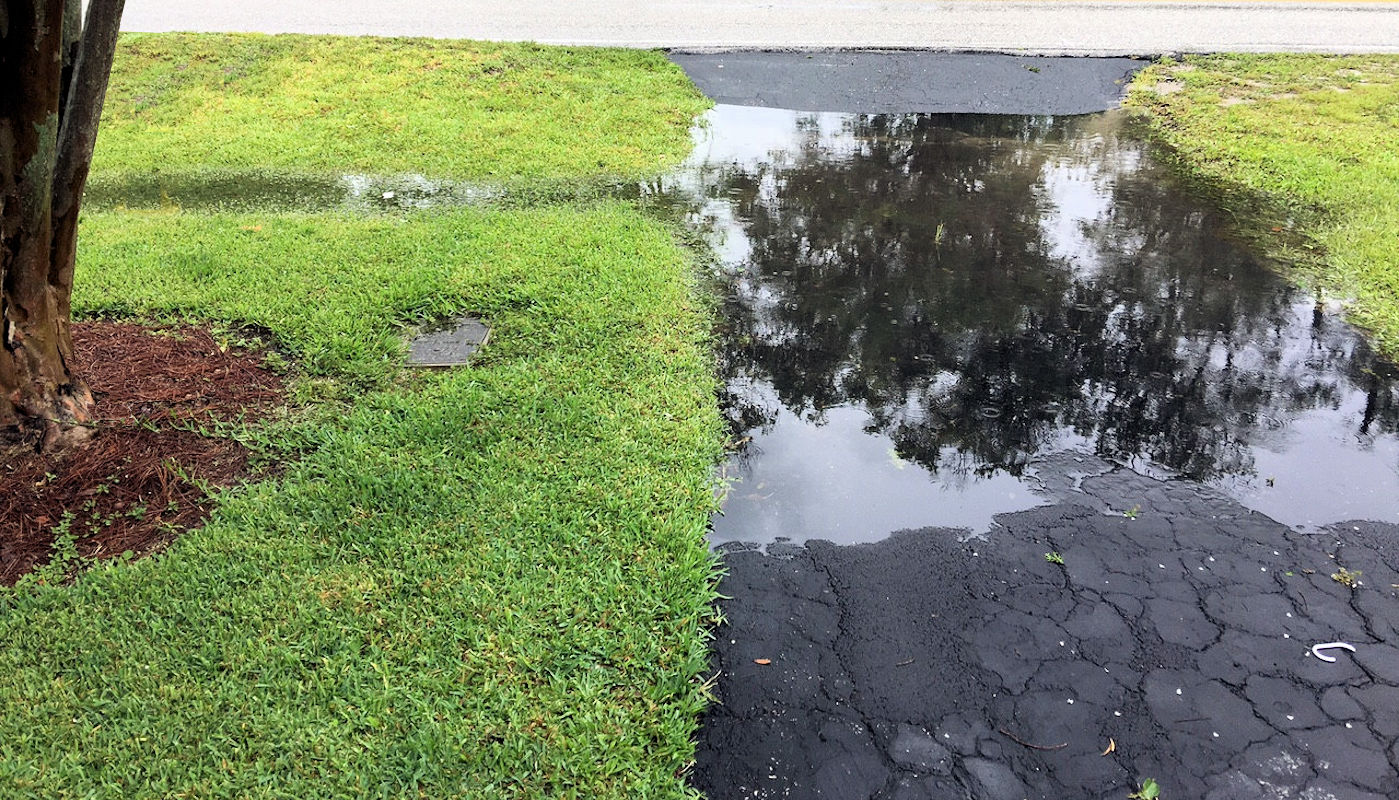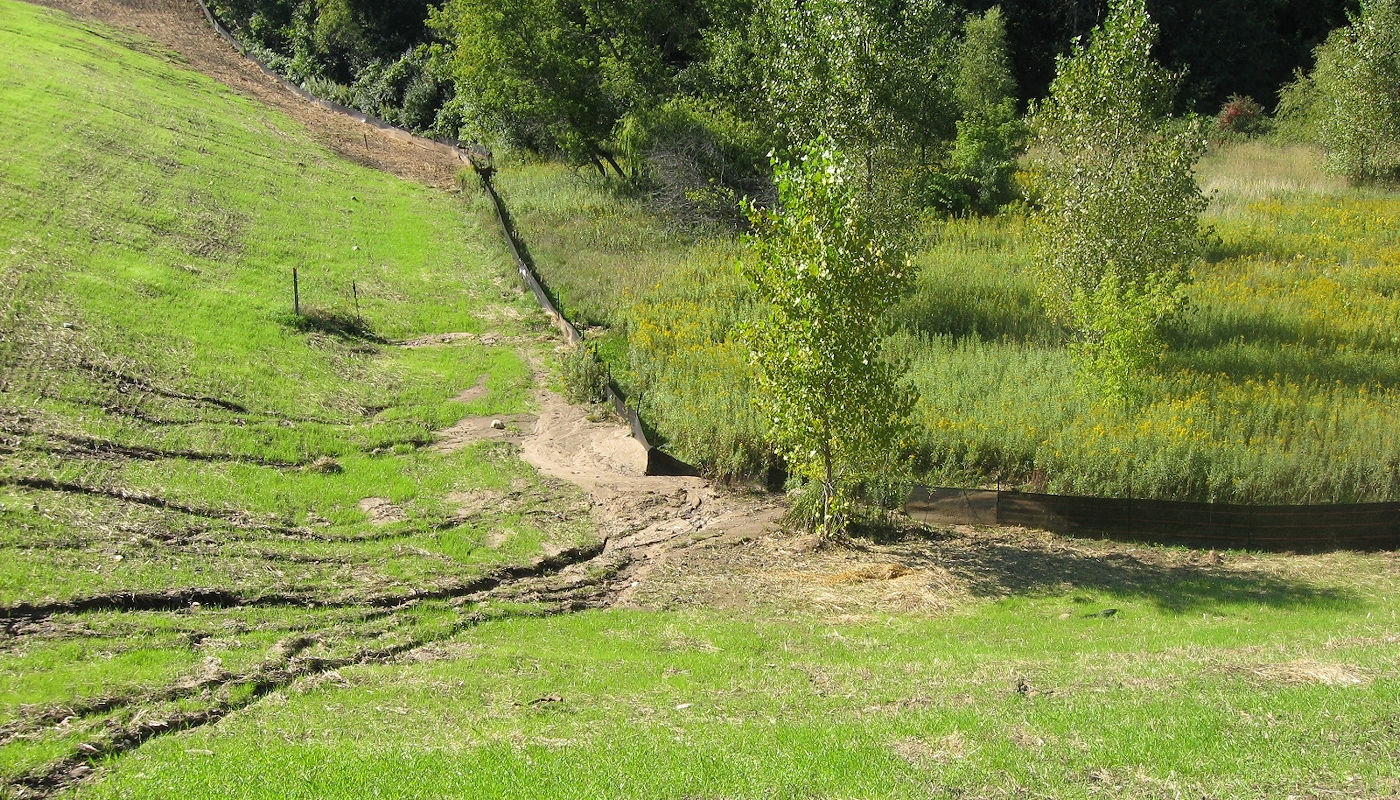

Soil Erosion Types & Solutions
Don’t Let Erosion Eat Away Your Property Value
Soil Erosion Types & Solutions
Don’t Let Erosion Eat Away Your
Property Value
Soil erosion is the process by which soil is removed from the land surface by wind, water, or other geological agents. This discussion about soil erosion focuses on erosion caused by stormwater runoff.
Various types of poor land management practices, including overgrazing, deforestation, overgrazing, intensive farming practices, and construction work, lead to avoidable soil erosion. To prevent soil erosion, it is important to implement sustainable land management practices such as planting vegetation, reducing tillage, using cover crops, terracing, contour farming, and the use of sediment basins and sediment fences. [1][2].
Land grading can also help prevent soil bank erosion by reshaping the ground surface to planned elevations, as approved construction drawings from a civil engineer or other qualified professional show. Land grading provides more suitable topography for buildings, facilities, and other land uses and helps control stormwater, soil erosion, and sedimentation during and after construction. When sites properly implement land grading with appropriate stormwater management and erosion and sediment control practices, land grading can mitigate stormwater flow from steep slopes and stabilize highly erodible soils.
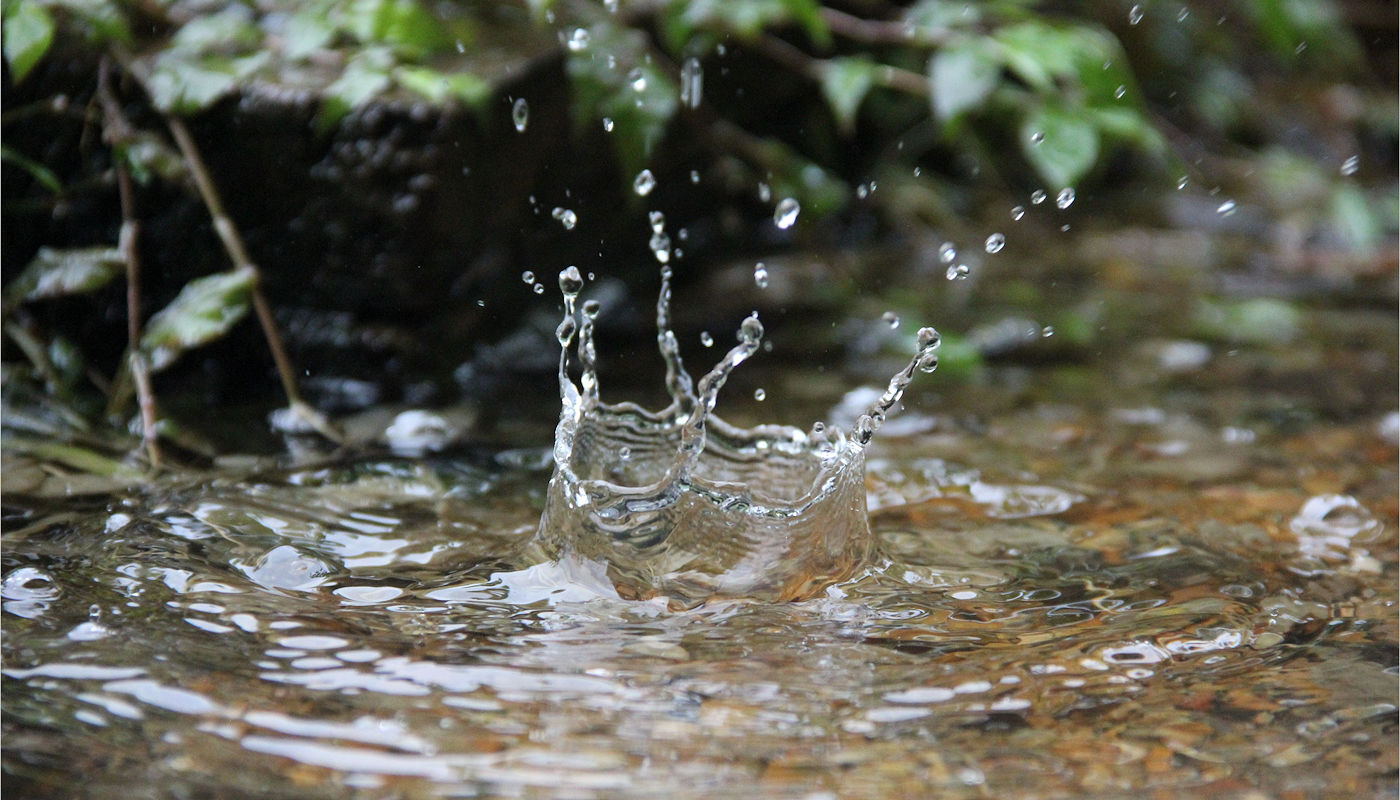
Raindrop Splash Erosion
The Raindrop, Erosion & the Sedimentation Process
The raindrop, erosion, and sedimentation processes are a sequence of events that involves the following steps that not only begin the soil erosion process, but see it transformed from one type of soil erosion to another as it evolves. Ultimately, these types of soil erosion are all the result of soil cover (grasses, shrubs, etc.) being broken down, exposing bare earth to the raindrops that begin the sequence.
For the sake of breaking this process down, consider raindrop erosion as an isolated incident, without stormwater accumulation and runoff erosion leading to the other forms of sedimentation (what happens with the soil as it settles into the various types of erosion: sheet, rill, gully, and bank). Of course, in a large enough rain event, the raindrop erosion is just the first step (or continuation of prior, largely unnoticed raindrop erosion that initially made the soil more vulnerable) of these types of erosion that seem to be a single event, rather than a chain of events.
Recognizing the earliest signs of soil deterioration provides the easiest and least expensive remedy to prevent soil erosion and avoid costly fixes later.
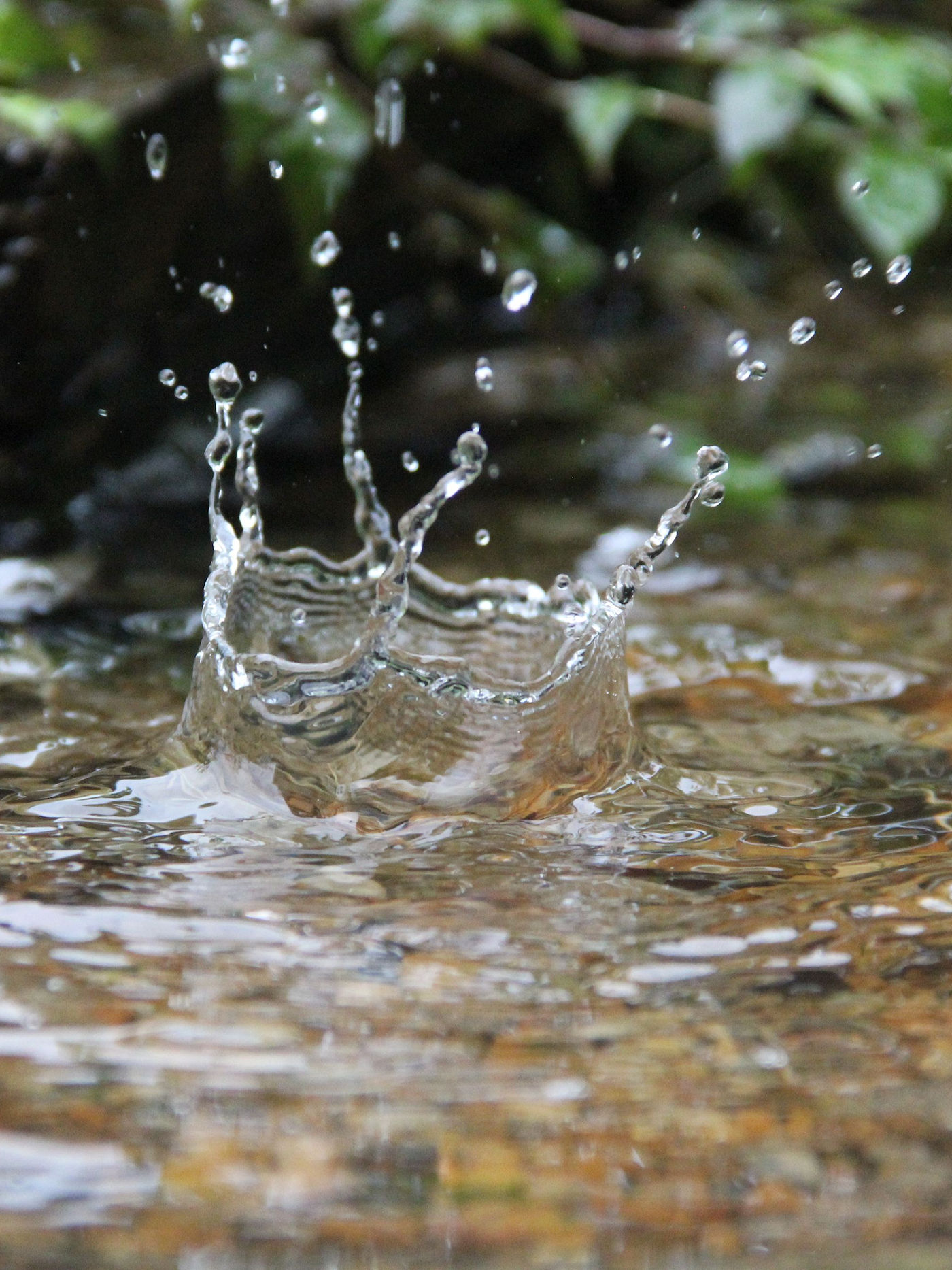
Beginning the Soil Breakdown:
Raindrops fall on the soil surface and dislodge soil particles, which then become suspended in the water droplet. This is called splash erosion¹².
What causes soil to deteriorate and become susceptible to the effects of raindrop erosion?
There are many factors that can cause soil to deteriorate and become susceptible to the effects of raindrop erosion. Besides failing to properly maintain your lawn and landscape, there are many human activities that can accelerate the natural process of soil degradation and make it more difficult for the soil to recover that lead to conditions that cause soil erosion.
Some of the main causes for soil breakdown that provides these conditions are:
Preventing Soil Deterioration
To prevent or reduce soil deterioration, it is important to adopt sustainable land management practices that protect the soil’s physical, chemical, biological, and ecological qualities. Some of these practices include¹²⁴⁵:
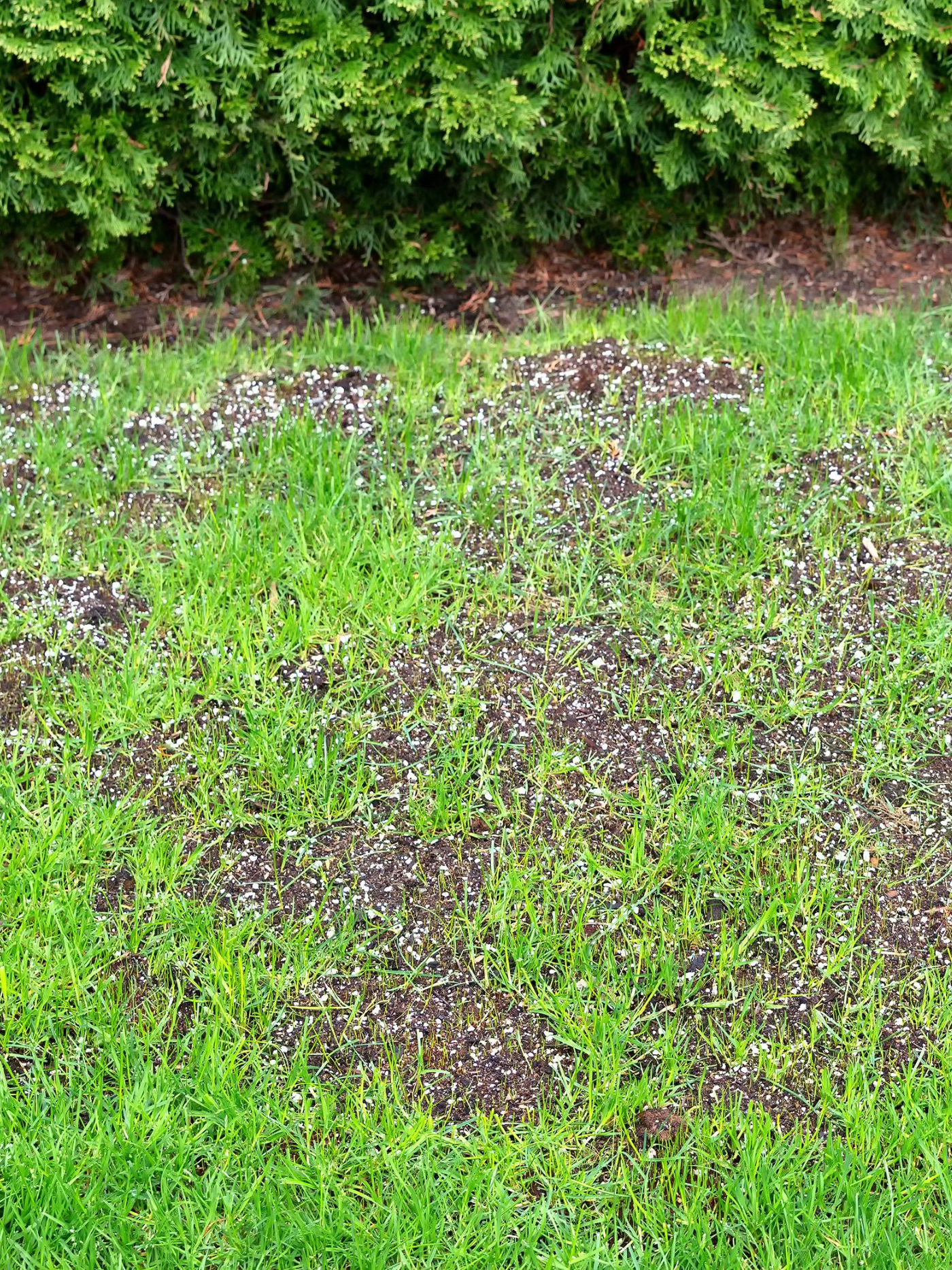
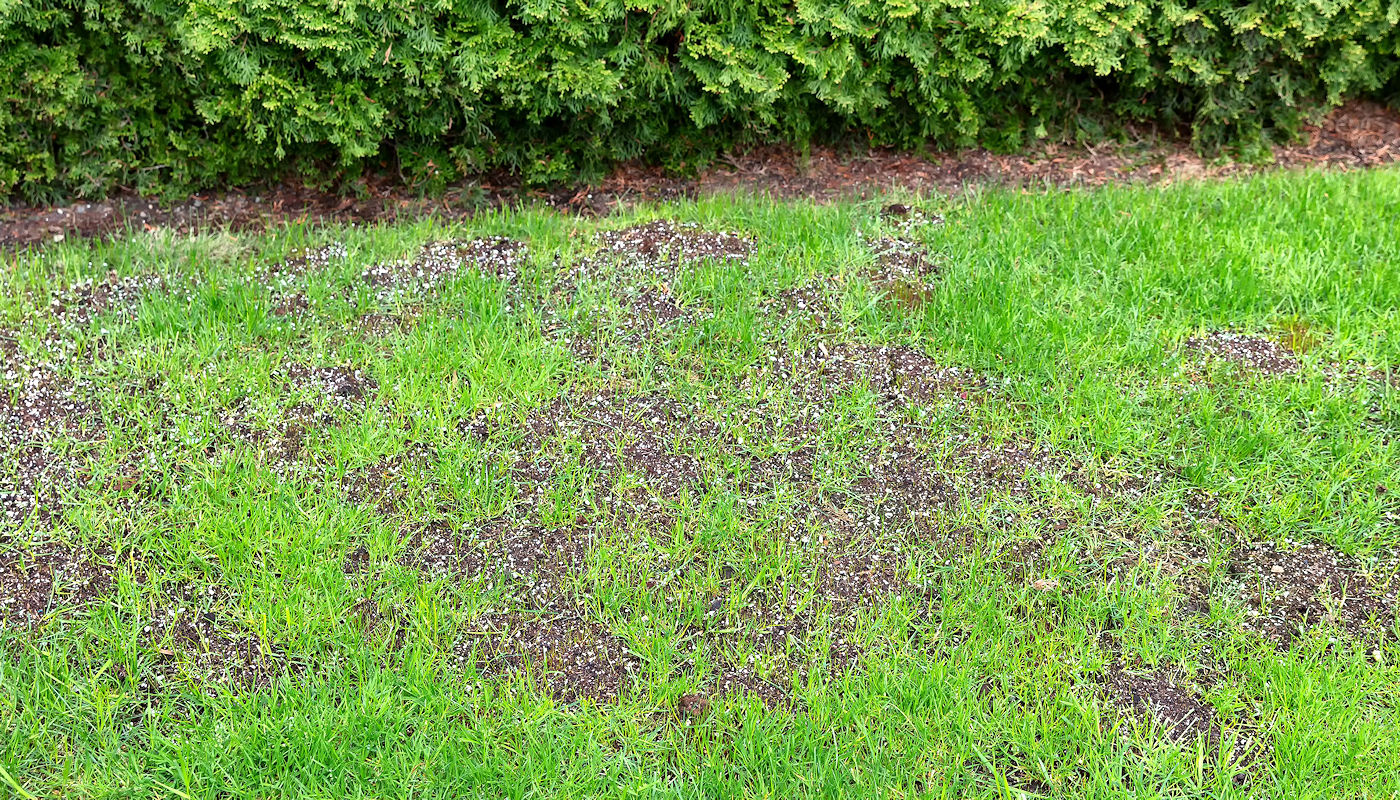
Water Erosion from 30,000 Feet
Moving water carrying tiny soil particles is followed by moving water that can flow into the tiny holes or bare spaces of unprotected earth where more soil particles are dislodged to join the erosion ‘sediment parade’. As the rain and stormwater runoff persist, thin ‘rills’ can begin to form from that initial point of soil disturbance. If the runoff continues, these rills can get increasingly wide, becoming ‘gullies’. At some point where the water flow slows and stops, this sediment settles, perhaps in a form called sheet erosion that is flat and smooth. Up whatever slope it came down, depending on many variables, you will see the rills and gullies from which the soil was removed to be deposited in that ‘sheet’.
It is what a property owner does or doesn’t do before the first drop of rainwater that sets the stage for erosion or pollution to come. This discussion is primarily about the types and causes of soil erosion. The discussion about prevention needs to be separated into construction sites and post-construction use of a property. Regardless of the use you intend for a project, construction will disturb topsoil and the grasses, shrubs, trees, etc. that allow it to resist the forces of erosion.
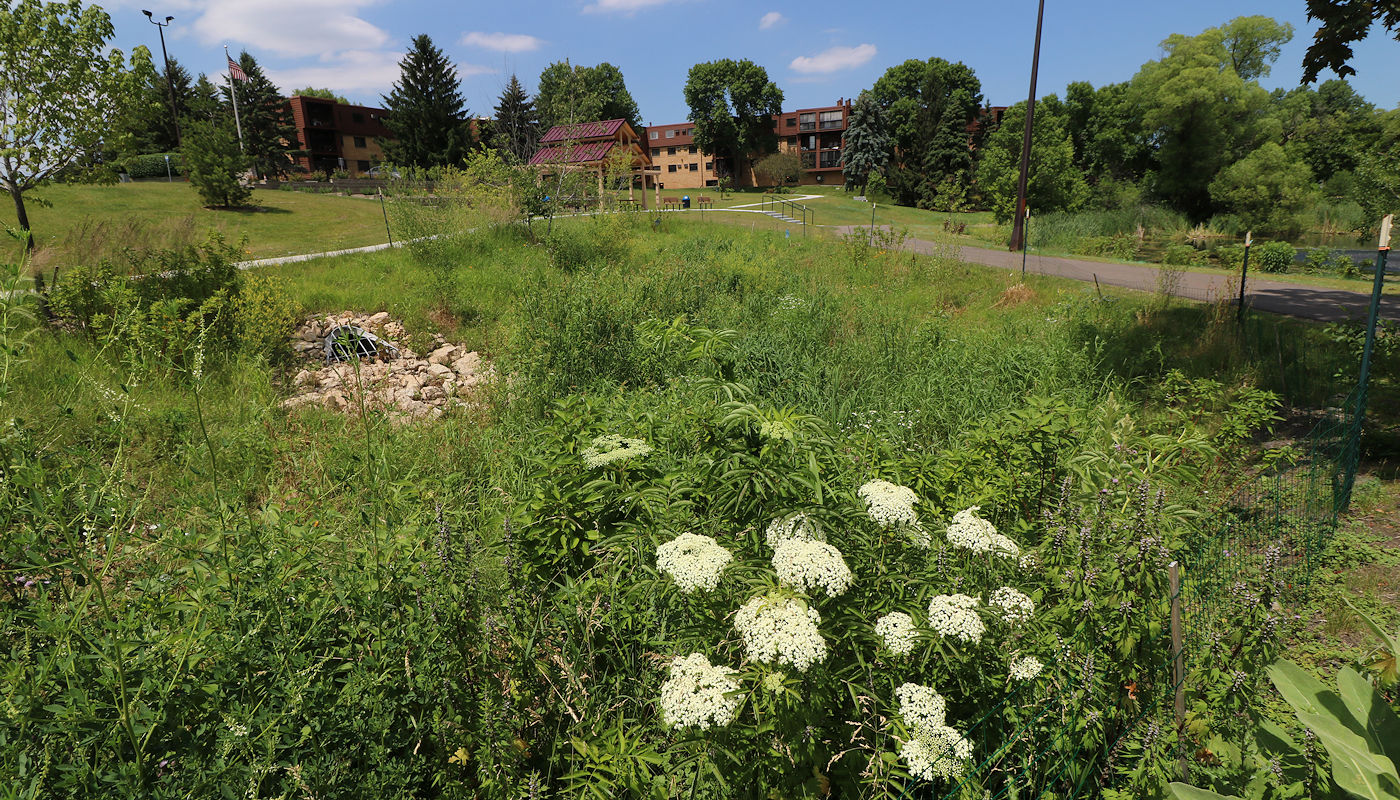
Erosion & Sediment Control Plan
Before any construction project begins, there should be an see Erosion &Sediment Control Plan that deals with the construction site issues during the building process, as well as a stormwater management post construction. There are exemptions for certain state permits. In Texas, for example, exemptions are based on projects that disturb less than one acre of land and are not part of a larger common plan of development, or for projects that disturb less than five acres of land and are in a county with a population of less than 50,000.
Whether your project requires an ESDP or not, if your construction takes weeks or months to complete, it will be exposed to enough weather events to warrant such a plan. You would want to be sure you had the budget and materials on hand to put it into action as soon as that need arose, and not be caught flat footed with little time to spare. At the small end of the project spectrum, this could include a single home or a parking lot.
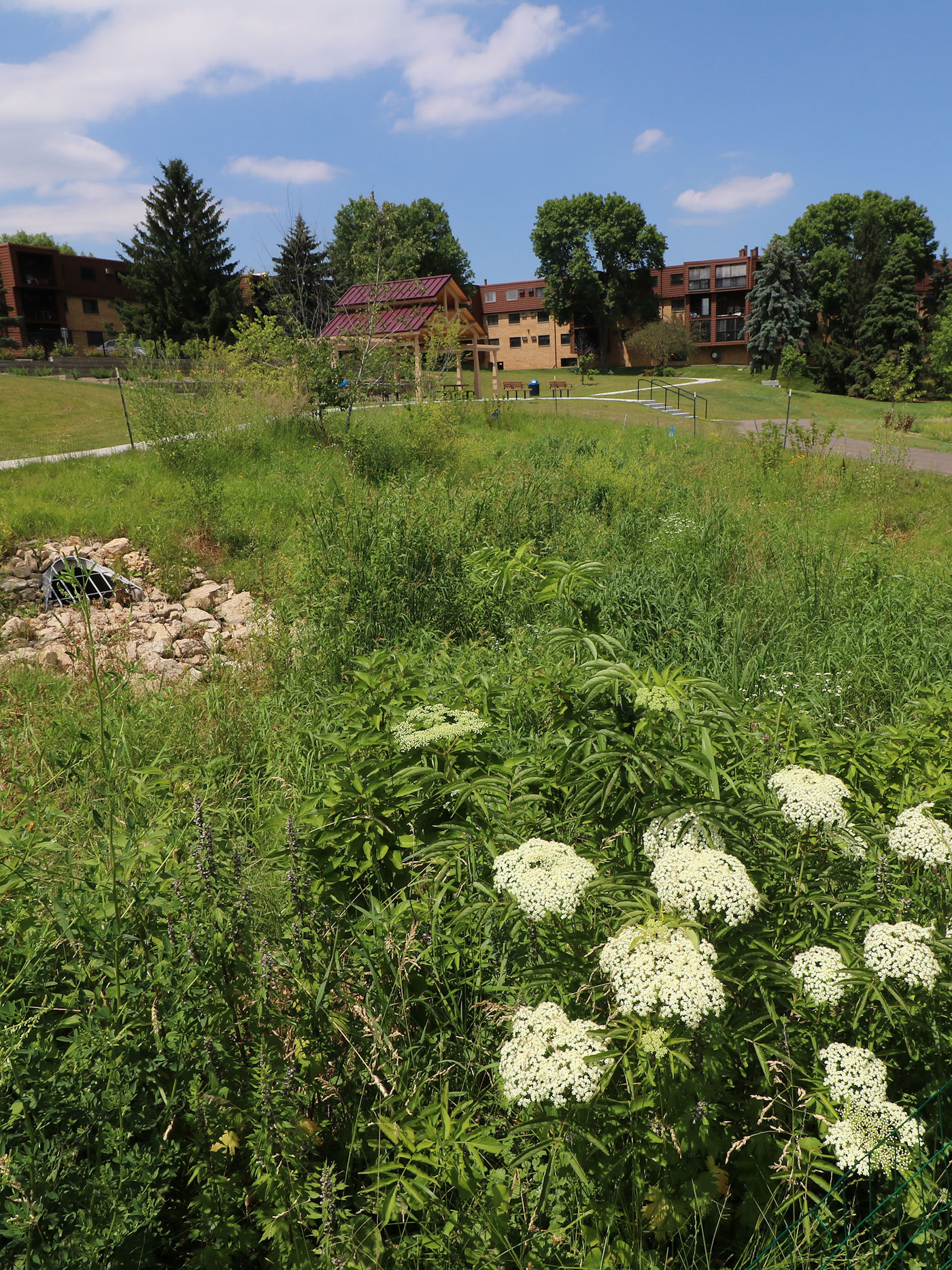
Post-Construction Rainscaping Considerations
The plan would include the post-construction consideration for handling stormwater runoff that you will build into the finished project to provide sustainable (and legal) stormwater drainage. The finished plan will prevent erosion and minimize the pollution that the water picked up from the urban hardscapes (roofs, driveways, parking lots, streets), or rural fields (containing fertilizer and pesticides), or rural ranches and operations raising various types of animals (dealing with animal waste)
These plans should include rainscaping features that have developed since 2008 that focus on managing stormwater at its source, whether it is a house or supermarket. This is a combination of landscaping that creates aesthetic results and drainage control to direct and store the water so that it can be filtered by the soil on your property before moving into a storm sewer or waterway as defined by the EPA. Depending on the amounts of water, these might include French drains, rock trenches, bioswales, raingardens, dry wells, dry retaining ponds, and more.
What types of erosion is caused by stormwater runoff?
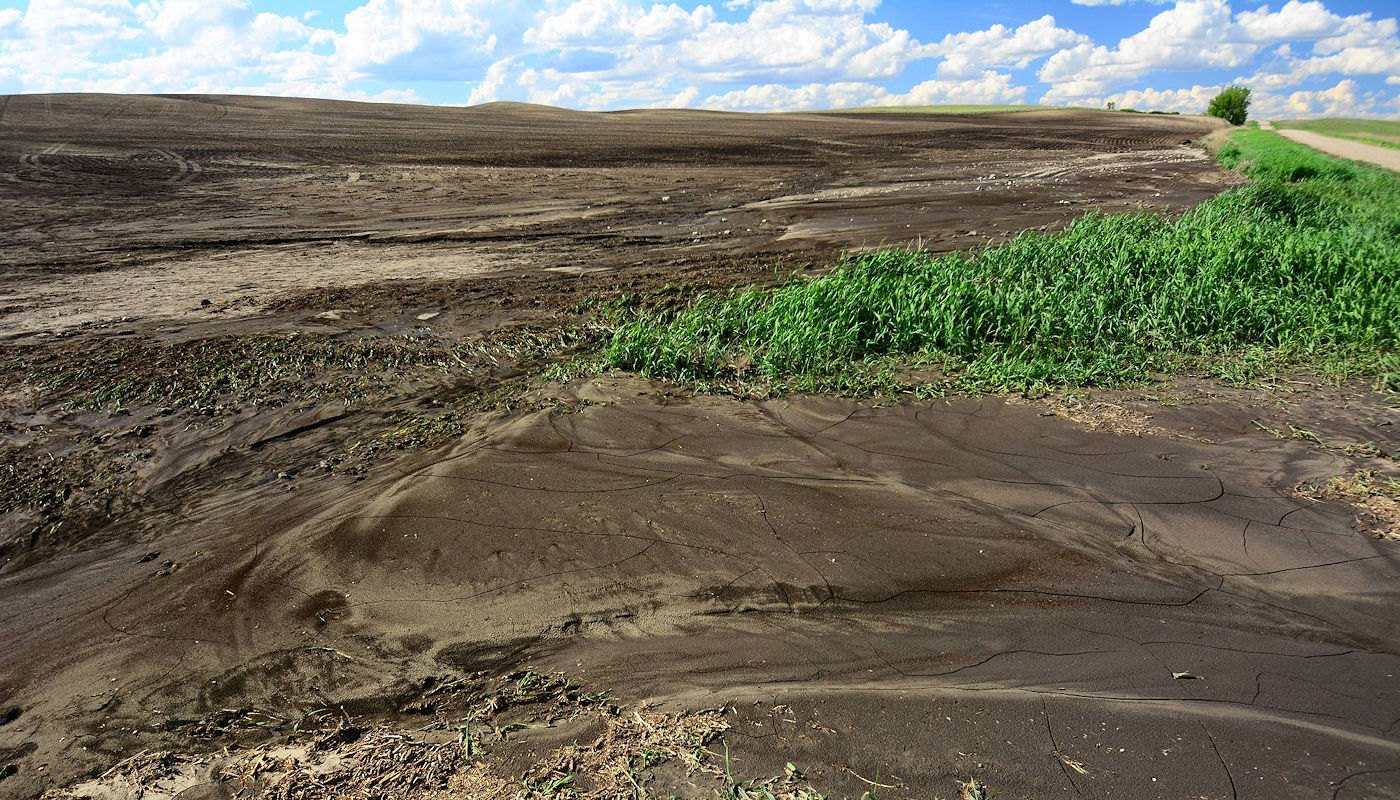
Sheet Erosion
Sheet erosion is a type of soil erosion that occurs when a thin layer of soil is removed from the land surface by raindrop splash and runoff. Sheet erosion is common in areas with low slopes and fine-textured soils [1-3].
To prevent sheet erosion, it is important to implement sustainable land management practices such as planting vegetation, reducing tillage, and using cover crops. Other measures that can be taken to prevent soil erosion include terracing, contour farming, and the use of sediment basins and sediment fences [1][3].
How can land grading help prevent soil sheet erosion?
Land grading can help prevent soil sheet erosion by controlling stormwater, reducing soil erosion and sedimentation, and stabilizing slopes. It can also decrease stormwater velocity and minimize the extent and duration of soil-disturbing activities during construction.
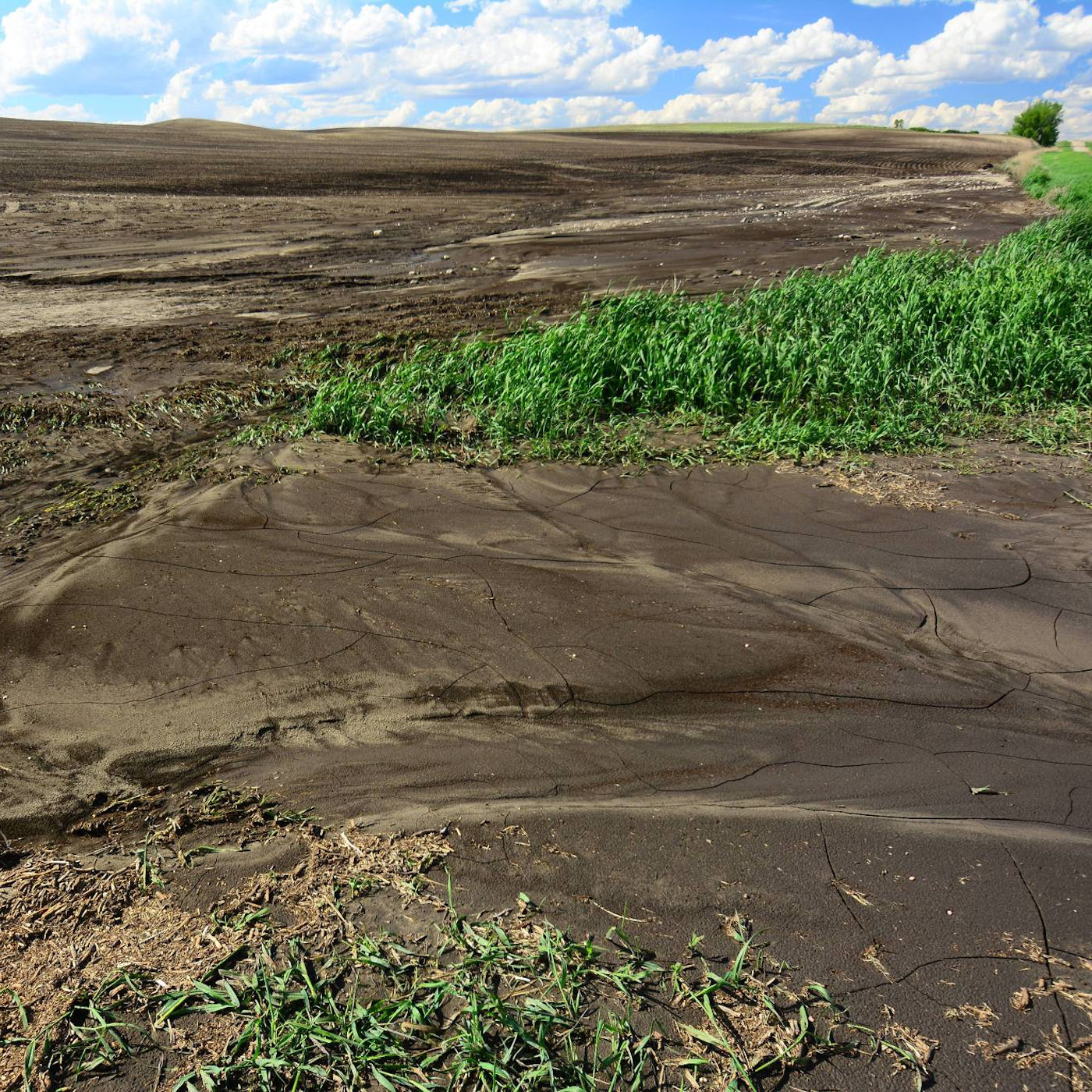
When preparing grading plans or other construction drawings that specify grading, a civil engineer or other qualified professional should account for existing soil types, existing slopes, existing drainage patterns, environmentally sensitive areas, proposed land use, and proposed stormwater control measures [1].
Here are some additional remedies for sheet erosion:
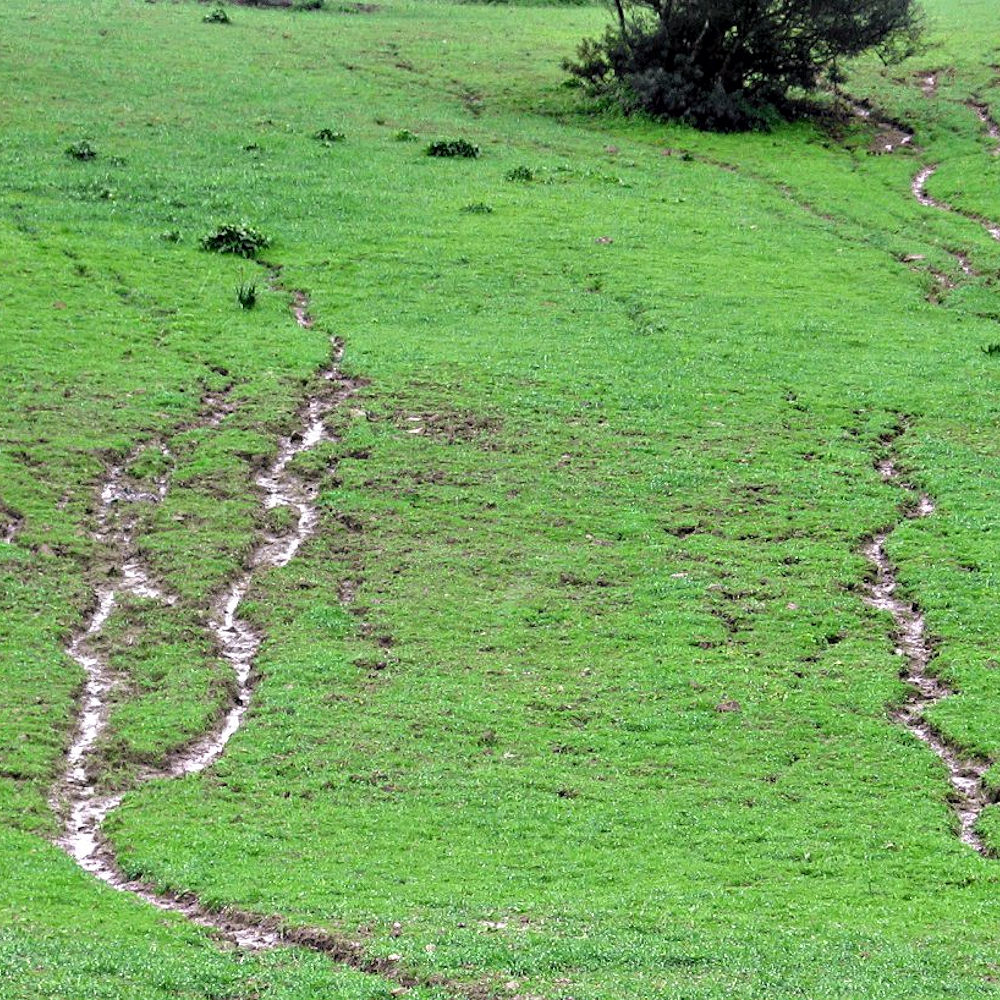
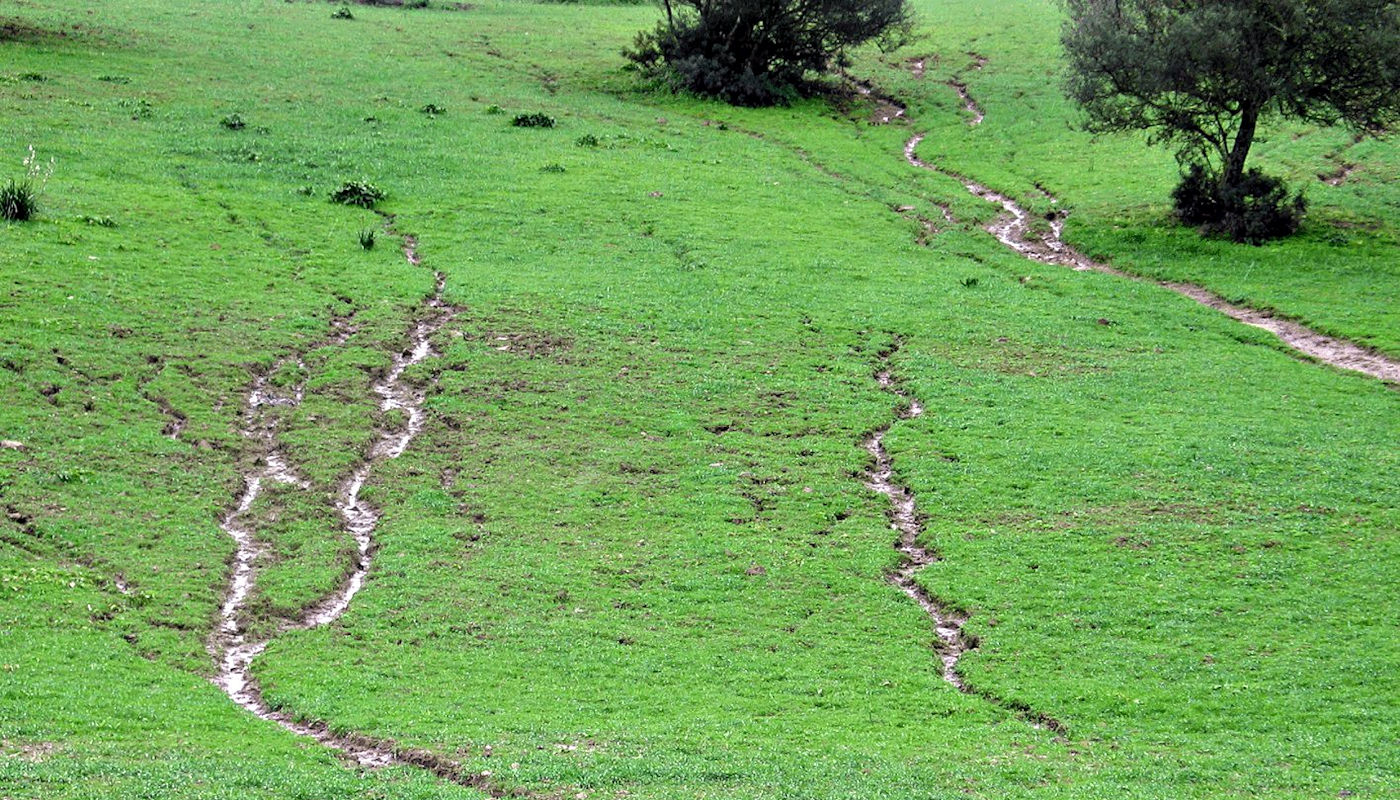
Rill Erosion:
This type of erosion occurs when small channels are formed on the soil surface by concentrated runoff. Rill erosion is common in areas with moderate slopes and medium-textured soils.
To prevent rill erosion, it is important to implement sustainable land management practices such as planting vegetation, reducing tillage, and using cover crops.
Here are some additional remedies for rill erosion:
Grassed waterways are designed to stabilize the area of concentrated flow and prevent rill erosion. They are the most common conservation practice used to address ephemeral gully erosion in fields [9].
Note that a bioswale is not a grassed waterway. A bioswale is typically a vegetated channel with a parabolic or trapezoidal cross-section that can be used in place of a ditch to transport stormwater runoff from streets, parking lots, and roofs. Bioswales are categorized by the type of vegetation used, and they are designed to mimic natural processes by using vegetation, soil, and microbes to filter pollutants from stormwater runoff.
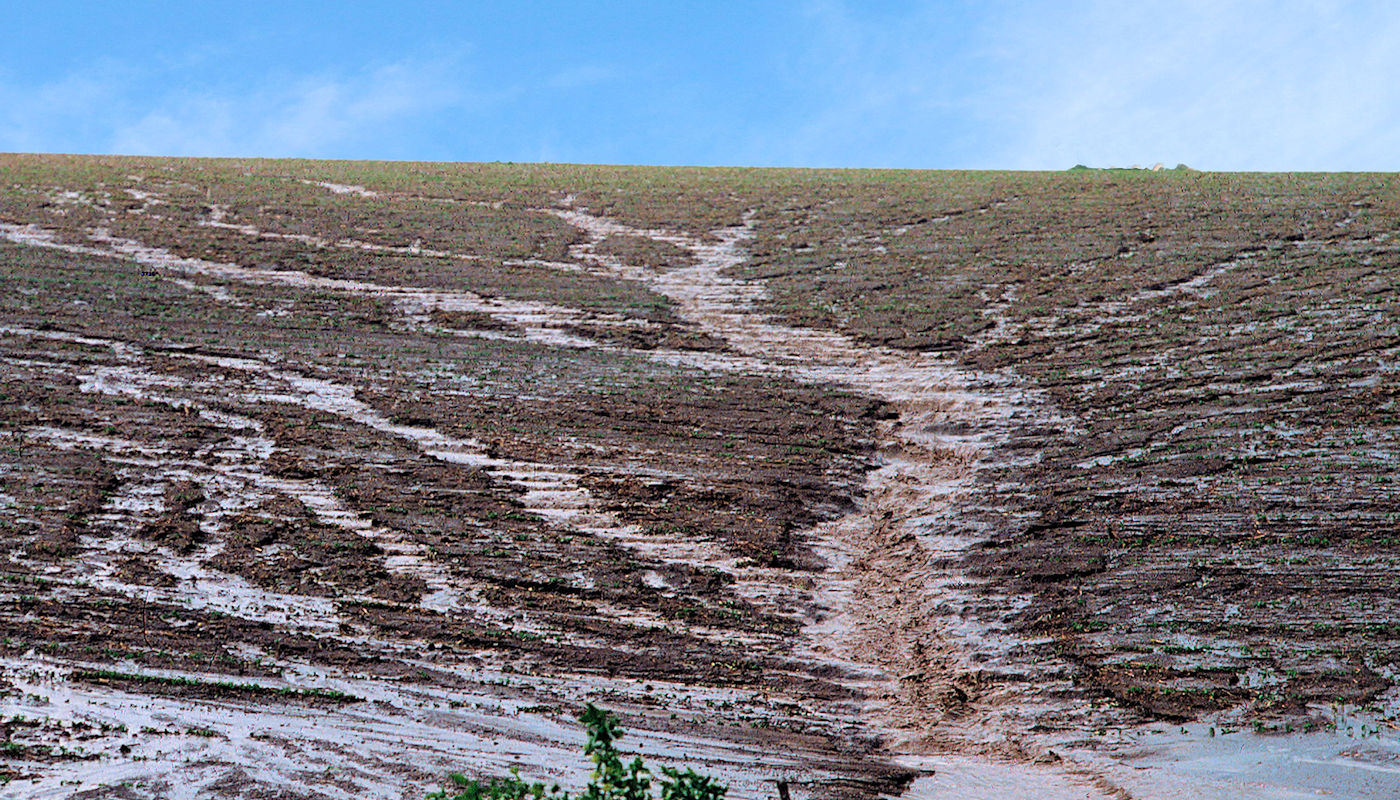
Gully Erosion:
Gully Erosion occurs when large channels are formed on the soil surface by concentrated runoff. Gully erosion is common in areas with steep slopes and coarse-textured soils. It’s important to understand the difference in gully types. While the “classic gully” (pictured) is most often what comes to mind unless you are a farmer, the “ephemeral gully” is the type most often dealt with in farming. The term “ephemeral” in the context of gullies refers to a temporary or seasonal nature.
Ephemeral Gullies
Ephemeral gullies are shallow channels cut by concentrated runoff where soil loosened by mechanical operations is removed, generally between tillage operations. These gullies typically erode to the tilled depth and are small enough to be passed over and filled in by normal tillage operations [20].
Of special note, ephemeral gullies recur in the same area each time they form rather than random places on the slope. Since they are shallow enough to plow over, they seem to be dealt with (disappear from tilling), hence the term “ephemeral” which means “short lived”. The recurrence in the same place shows that they were simply covered and not repaired.
This type of gully frequently forms in well-defined depressions of natural drainage ways and tends to occur in the upper reaches of a drainage network. They usually branch but may have patterns caused by row alignment or other characteristics of field operations [21].
Classical Gullies
Classic gullies, compared to the shallow ephemeral gullies, are more than 1.5 feet deep and cannot be easily driven or tilled across. They lead to significant disfigurement of the landscape, rendering it unfit for crop production, another attribute that differentiates them apart from ephemeral gullies.
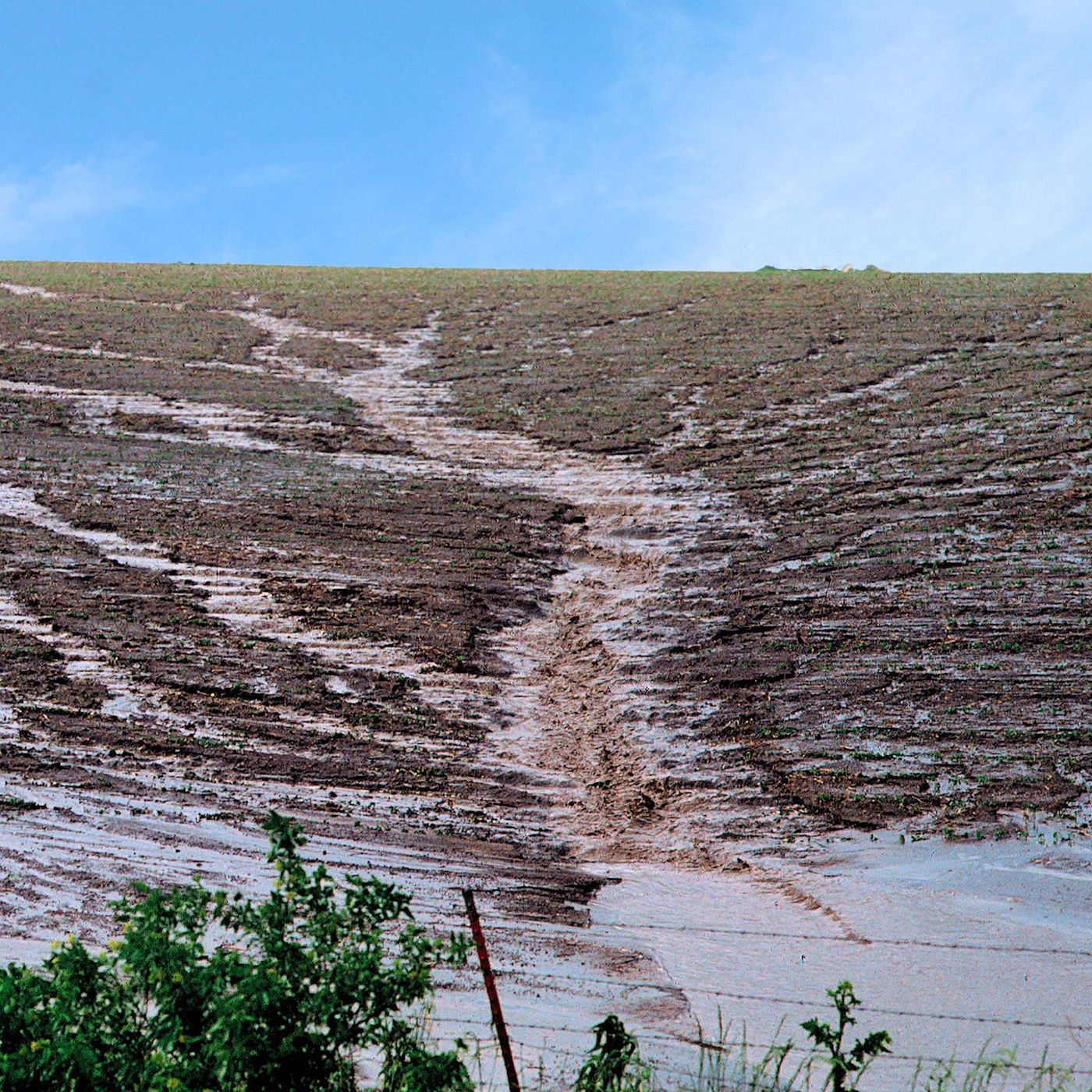
Ephemeral Gully Erosion in Tilled Field
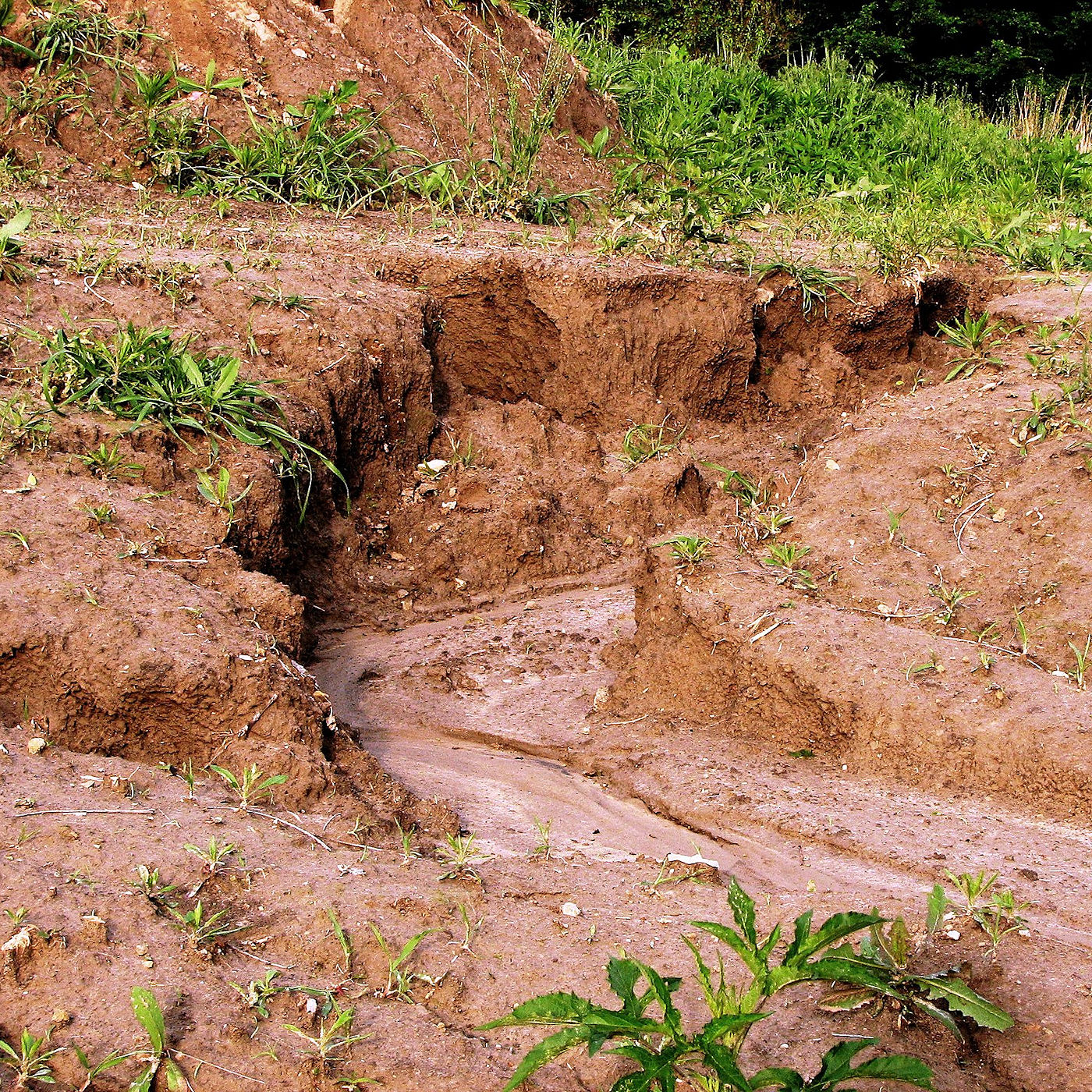
Classic Gully Erosion: Gully Head Formation
To prevent soil erosion caused by stormwater runoff, it is important to implement sustainable land management practices such as planting vegetation, reducing tillage, and using cover crops. Other measures that can be taken to prevent soil erosion include terracing, contour farming, and the use of sediment basins and sediment fences [11][12][13].
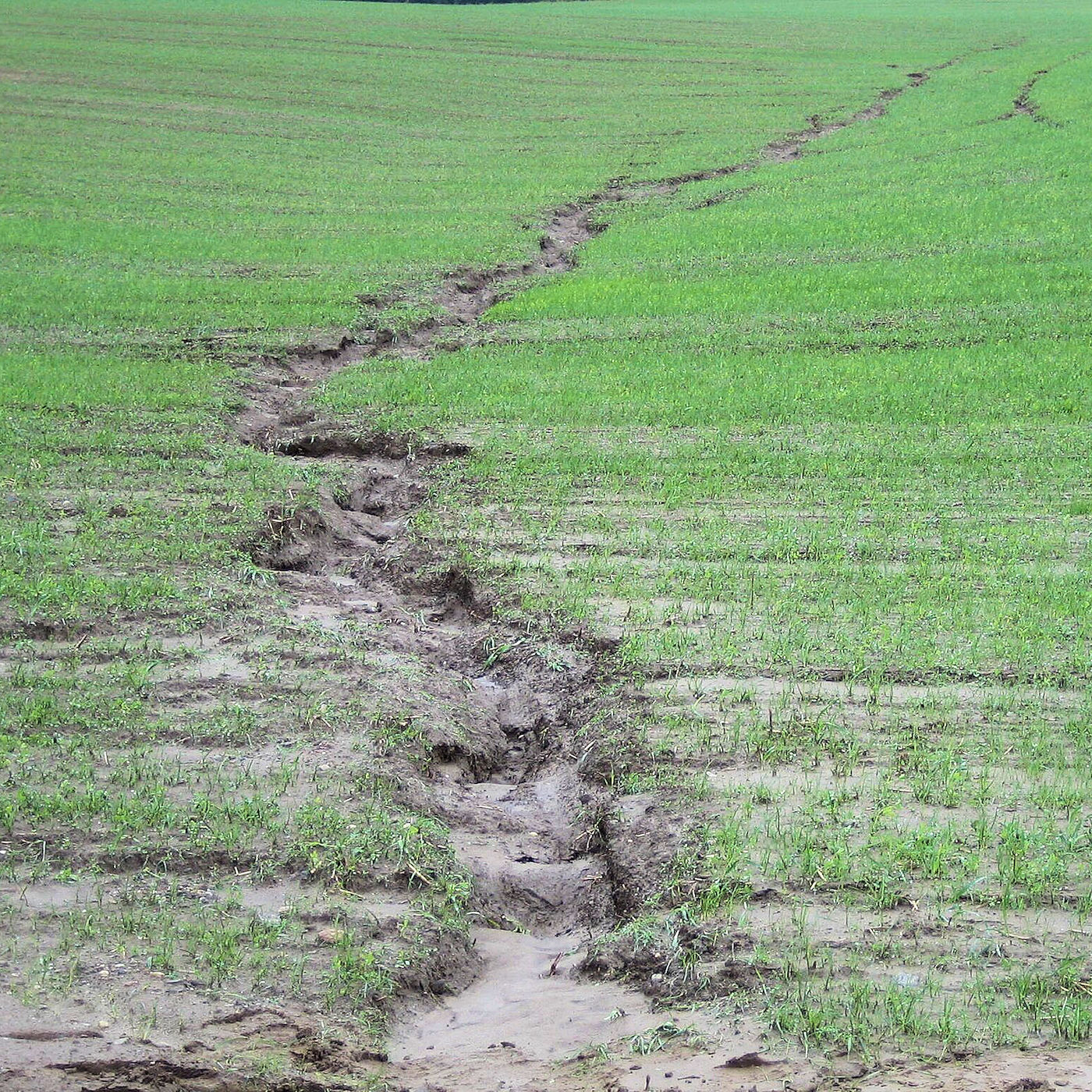
Bank Erosion in Tilled Fields
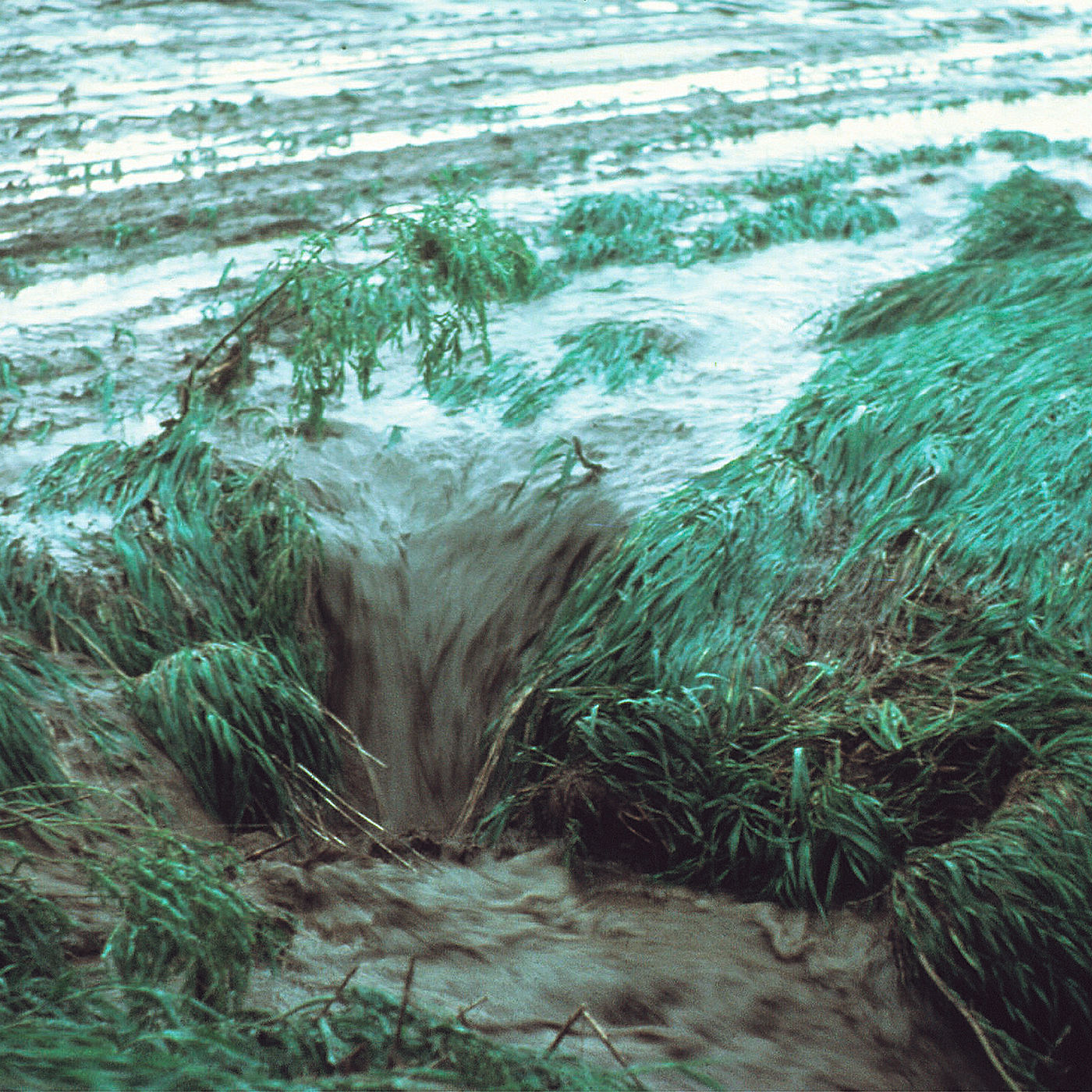
Bank Erosion in Tilled Field at Gully “Head”
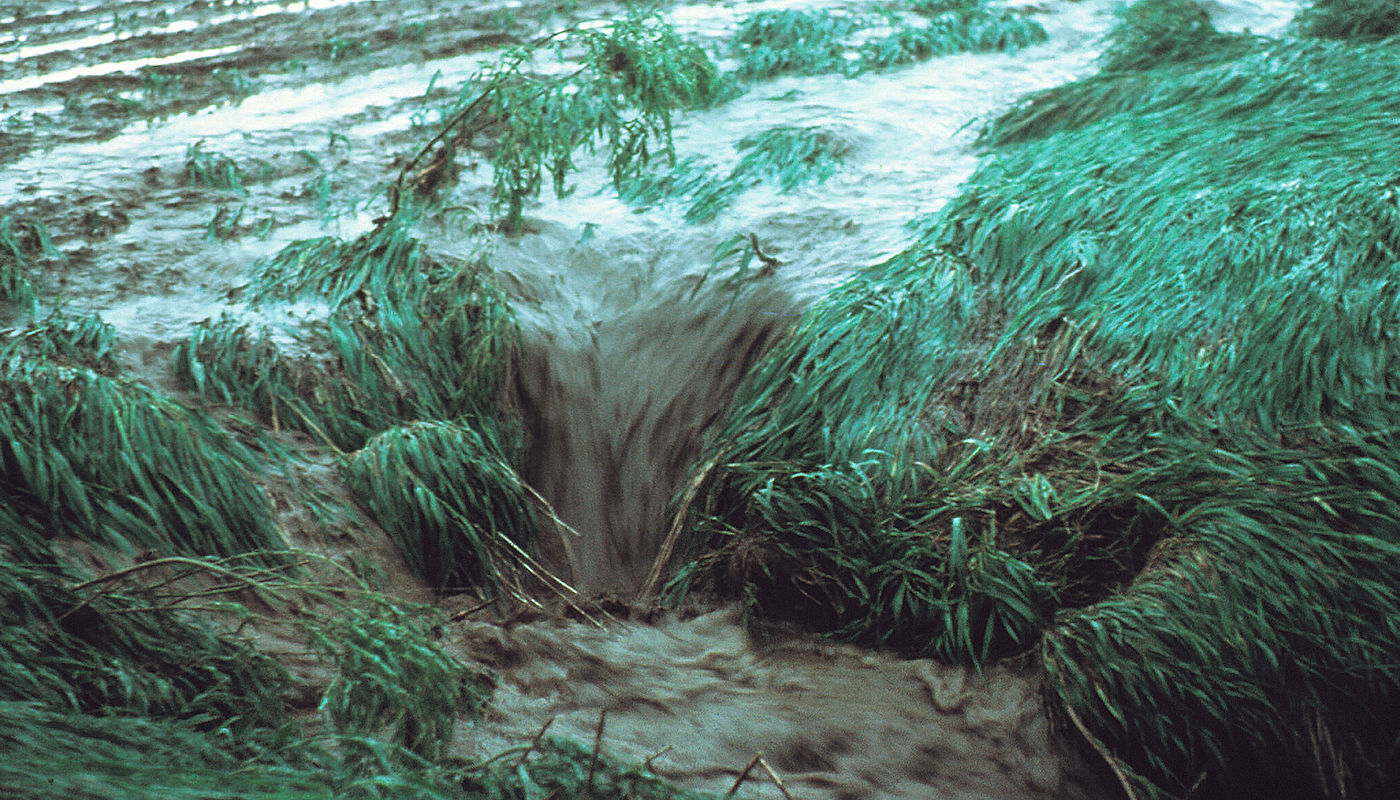
Farmland Bank Gullies
Bank Gullies on Farmland, particularly those that form on terraces or raised farmland, (not to be confused with riverbank or other waterway bank erosion) are a type of erosion that occurs when water flow, such as from a rill or an ephemeral gully, crosses and erodes an earth bank (such as a terrace). This can happen when the water flow is concentrated in a particular area, leading to the formation of a gully.
In the context of terraces or raised farmland created to control or slow stormwater runoff, these gullies can form when the land’s capacity to absorb water is exceeded, especially during heavy rainfall. For instance, terraces are typically designed to handle runoff from a 1-in-10-year storm. If the rainfall exceeds this capacity, the terraces may be overtopped by runoff, causing erosion of the terrace ridge, terrace back slope, and lower terraces, and potentially resulting in severe gullies [Q8-1].
The spatial distribution (surface arrangement) of these gullies can vary. Hillslope ephemeral gullies often show a clear aspect asymmetry pattern, while the distribution of bank gullies is typically symmetrical. Bank gullies are generally larger and more permanent than ephemeral gullies, often requiring specific reclamation practices to repair.
It’s important to note that regular maintenance and checks, especially after rains, can help prevent the formation of these bank gullies. This includes ensuring that terraces have adequate capacity, ridge height, and channel width [Q8-1]. Additionally, improving soil structure with continuous no-till and leaving residue on the soil surface can help reduce crusting, allowing more water to infiltrate into the soil, decreasing runoff, and reducing the formation of rills and gullies [Q8-2].
Stormwater runoff contributes to any type of gully erosion by increasing the velocity and volume of water flowing over the ground surface. When stormwater flows over the ground surface, it can pick up and transport soil particles, which can lead to soil erosion and gully formation. Gully erosion is the removal of soil along drainage lines by surface water runoff [11][12].
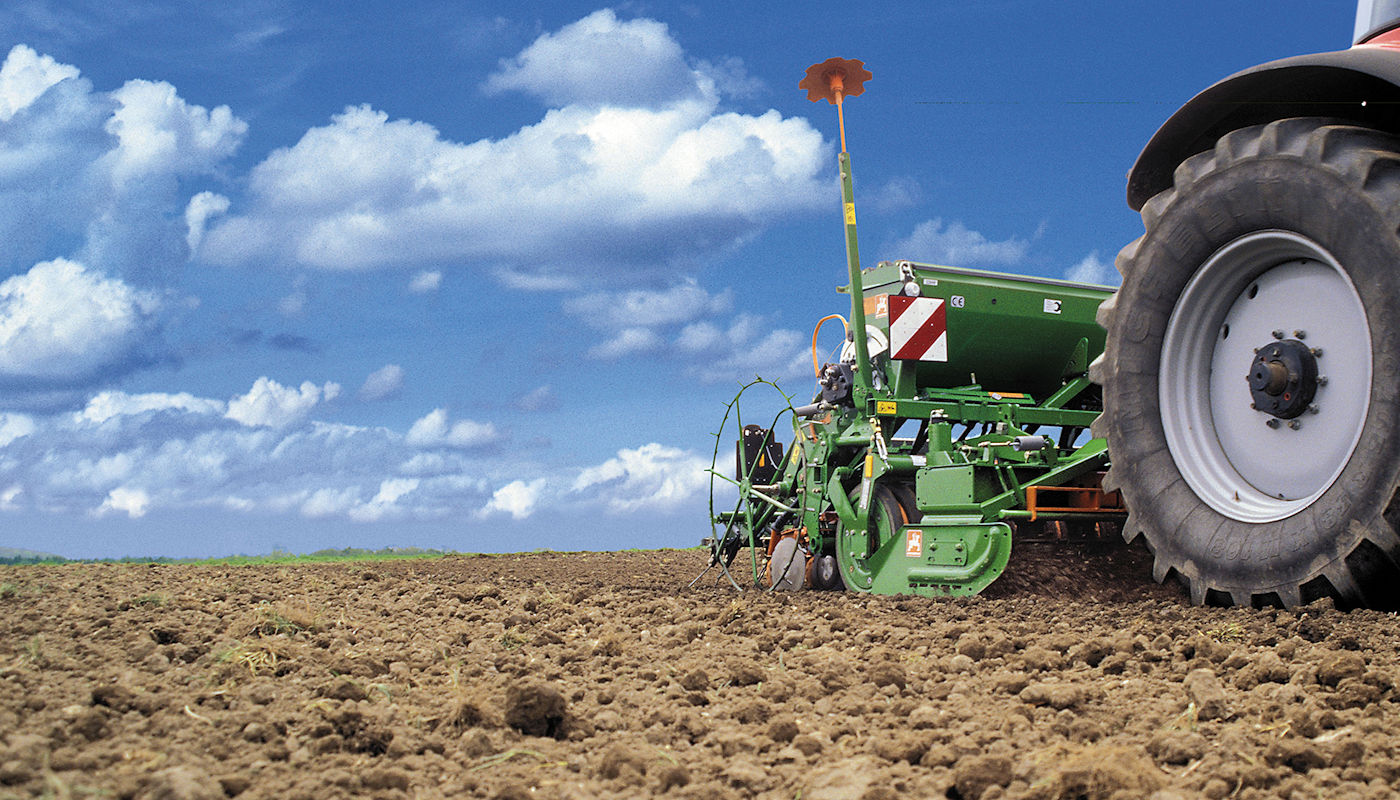
Tillage Erosion: Causes & Mitigation
Tillage erosion is a form of soil erosion that occurs in cultivated fields due to the movement of soil by tillage [Q9-3]. It involves three distinct actions: soil detachment by the use of a tool, redistribution of the soil through movement, and deposition of the soil elsewhere [Q9-2].
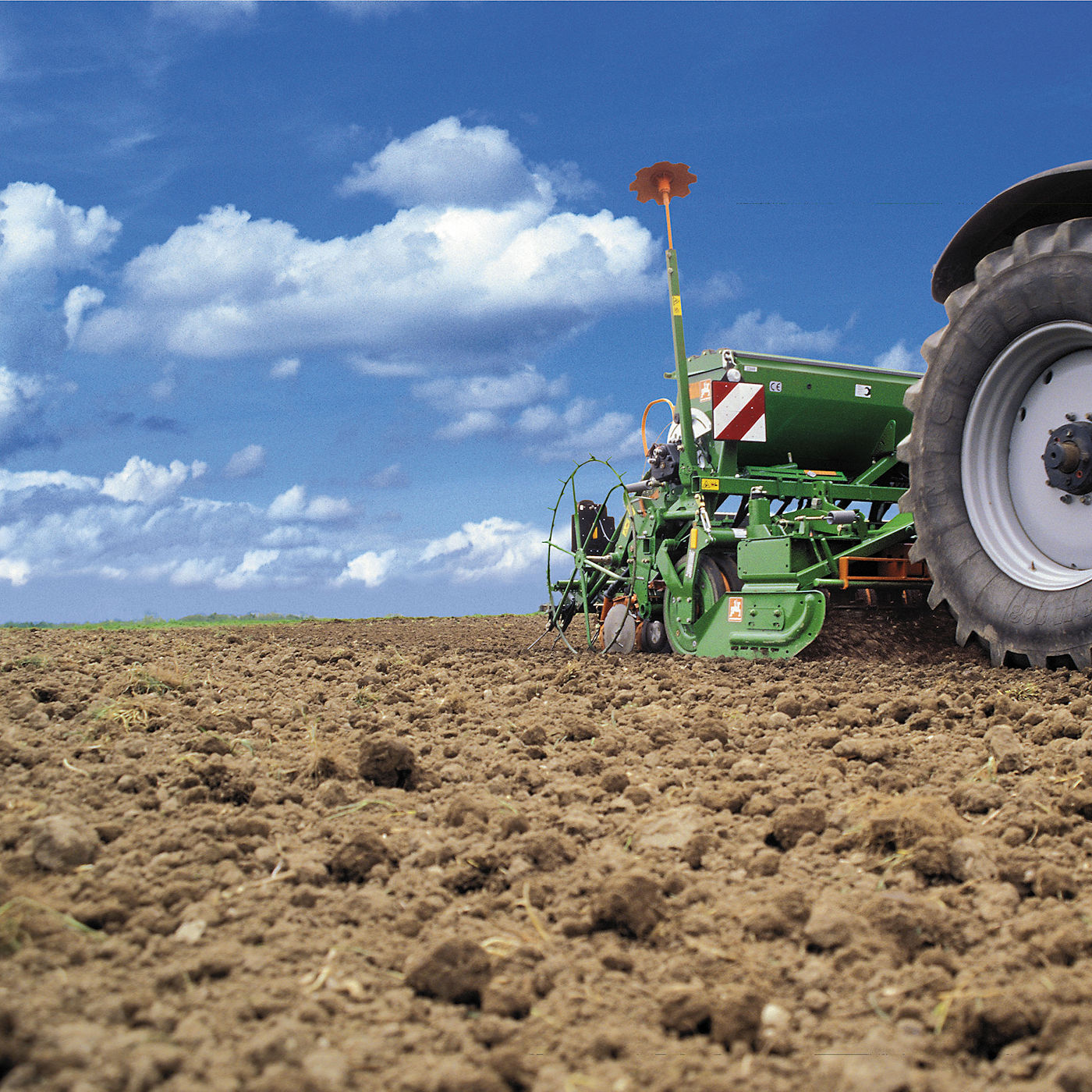
Farmland Tillage Erosion Control
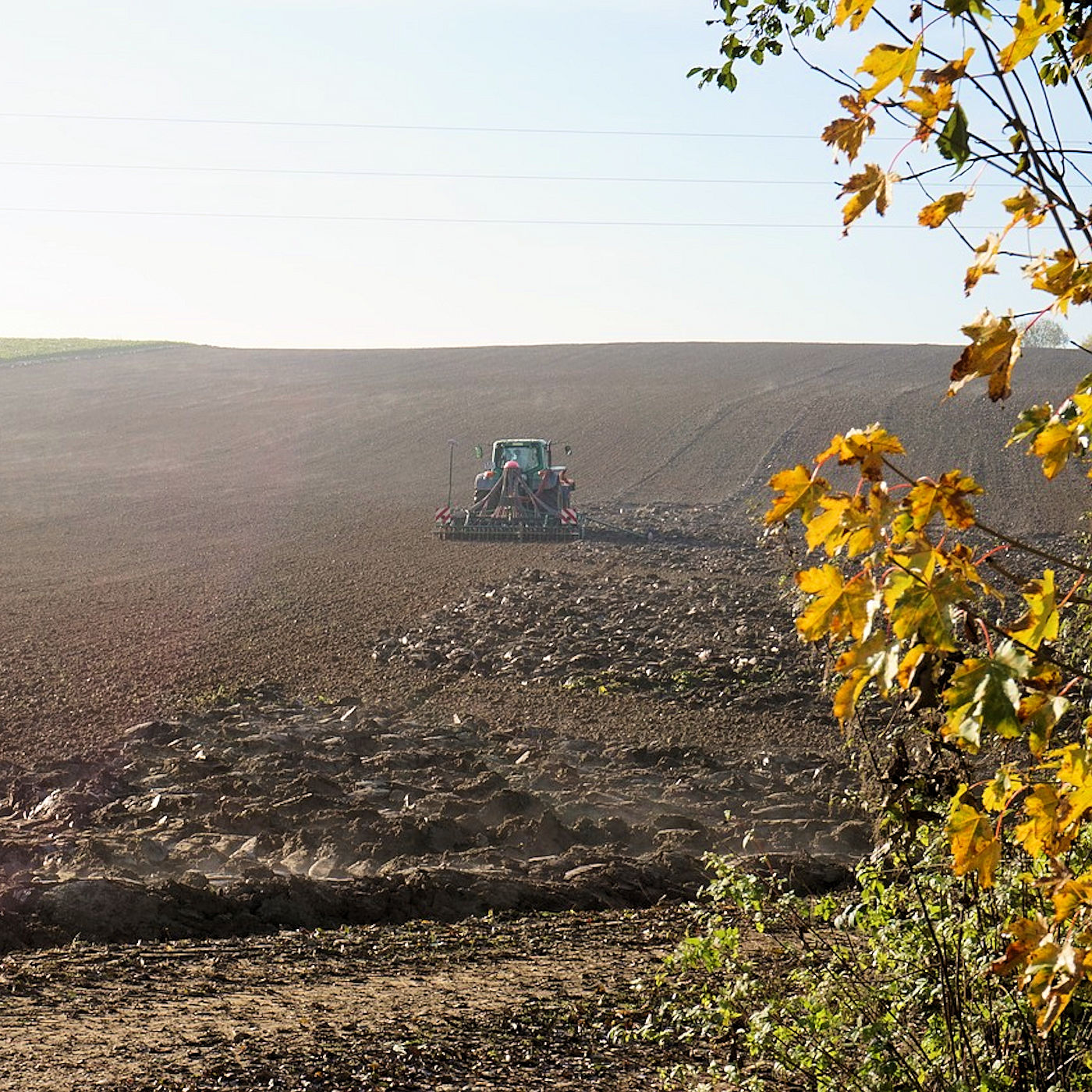
Farmland Tillage Erosion Control
Some of the best management practices (BMPs) that can be used to prevent, reduce, or repair gully erosion and sedimentation include:
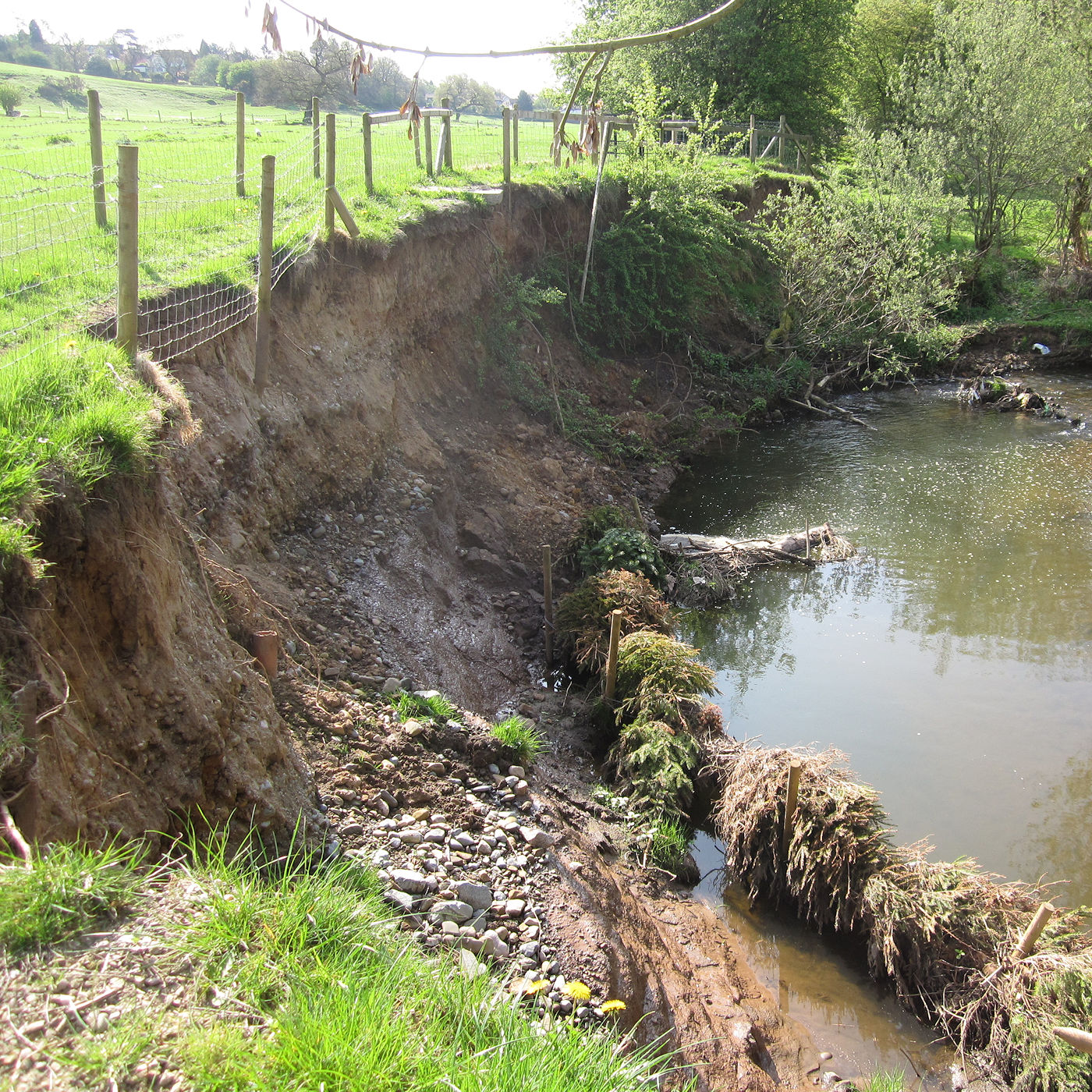
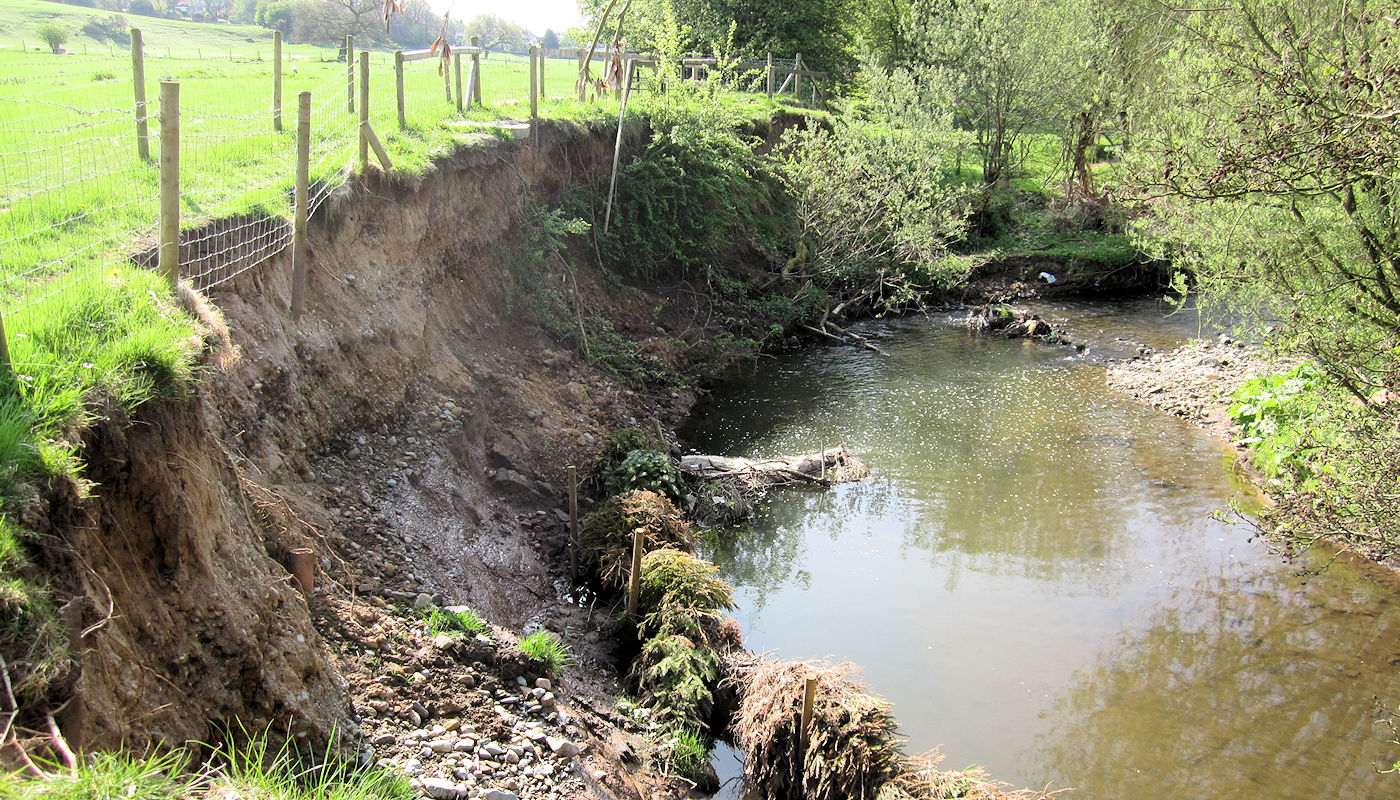
Bank Erosion (along waterways):
Stormwater runoff can contribute to soil bank erosion by carrying away soil particles and increasing the velocity of water flow, which can cause the soil to erode more easily. This can lead to the loss of valuable topsoil, the destabilization of stream banks and other waterways [15], and the loss of valuable land and damage to infrastructure[17].
To prevent, reduce, or repair bank erosion, there are several measures that can be taken. One such measure is the use of “riprap”, which is a layer of large stones that protects soil from erosion in areas of high or concentrated flows. It is especially useful for armoring channel and ditch banks, among other features. Other methods include redirecting runoff to vegetated areas, covering exposed soils with erosion control blankets, and surrounding storm drains with filter socks [16][17].
Land grading can also help prevent soil bank erosion by reshaping the ground surface to planned elevations, as approved construction drawings from a civil engineer or other qualified professional show. Land grading provides more suitable topography for buildings, facilities, and other land uses and helps control stormwater, soil erosion, and sedimentation during and after construction. When sites properly implement land grading with appropriate stormwater management and erosion and sediment control practices, land grading can mitigate stormwater flow from steep slopes and stabilize highly erodible soils [18].
Erosion Control Services & Solutions:
Erosion Control Related Topics:
Resources
- 1
Coming soon.


